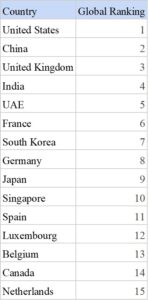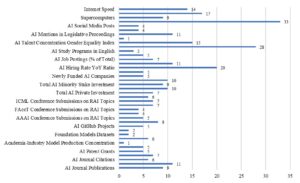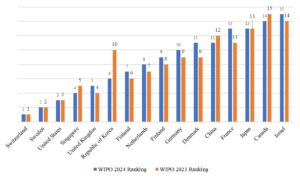Establishing an innovation-driven international policy agenda for Canada
Author(s):
Renata Thiébaut

Disclaimer: The French version of this text has been auto-translated and has not been approved by the author.
The trade war serves as a critical alert for the next Canadian government to adopt an innovation-driven agenda based on international partnerships. Europe should be at the forefront of Canada’s prioritized international partnerships.
Keywords: Trade war, foreign policy, trade
Introduction
The trade war initiated by the U.S. President Donald J. Trump during the initial months of his second term has underscored an urgent need for a Canadian independent foreign policy. The adoption of a strategic and assertive international agenda is suggested with the prioritization of partnerships with nations at the forefront of critical technological sectors. Canada should aim to become a global leader in artificial intelligence, imperative for achieving key objectives set forth in the Pan-Canadian Artificial Intelligence Strategy.
According to a report released by Microsoft and Accenture, generative AI alone can contribute $187 billion to the Canadian economy by 2030. This technology can become a catalyst for the country’s economic growth while improving its global competitiveness. To exemplify, the release of DeepSeek, a Chinese open-source generative AI software developed at a significantly lower cost compared to OpenAI’s ChatGPT, corroborates with the idea that Canada can and must invest in its own indigenous technologies. To be precise, 46% of Canadian employees use generative artificial intelligence tools in their jobs, however, only 18% of them state that their employers have not officially implemented generative AI use.
Exhibit 1. Stanford University’s 2023 Global AI Vibrancy Ranking (Source: Stanford University Global AI Vibrancy Tool)

Canada ranks 14th in the Stanford University’s 2023 Global AI Vibrancy Ranking. Though the country has achieved significant levels of development in AI-related sectors, such as biopharmaceuticals and healthcare, much more can be accomplished, as the index indicates. The fact that several European countries with relatively smaller economies have better performance than Canada, reveals that fostering a favorable environment which encompasses robust government support, critical thinking and cross-country collaboration is the key for future performance improvements.
Canada ranks number one globally in Academia-Industry Model Production Concentration and number two in Foundation Models Datasets and Foundation Models Applications, indicating an existing robust foundation and ecosystem for AI innovation between academic institutions and industry, as well as significant contributions to the development and deployment of foundational AI technologies. A granular analysis is helpful to understand shortcomings, guiding future policies and directives, which should be sectoral based.
Compute Capacity (Rmax) and Internet Speed deserve attention, ranking 17th and 14th respectively. It indicates the country’s current infrastructure and ability to support advanced AI development and deployment is not adequate. Finally, AI Hiring Rate YoY Ratio, which ranks 20th, and AI Study Programs in English Penetration, in 28th, can be interpreted as insufficient growth in AI-specific employment opportunities, as well as incipient ability to attract and retain international AI talent. While digital literacy must continue being the pillar of technological advancements, Canada must continuously expand its AI workforce. This scenario might be further exacerbated with an unemployment burst caused by the trade war.
Exhibit 2. Stanford University’s 2023 Global AI Vibrancy Ranking – Canada (Source: Stanford University Global AI Vibrancy Tool – Canada)

Canada also ranks 14th in the 2024 World Intellectual Property Organization’s index. European countries such as Switzerland and Sweden lead the ranking. What drives both the AI Global Vibrancy and Innovation indexes is the capacity to develop indigenous technologies, rather than relying on imported solutions. Becoming self-sufficient in technological development will sustain Canada’s global competitiveness in the AI sector.
Exhibit 3. The top 15 innovators, 2023–2024 (Source: World Intellectual Property Organization (WIPO))

While cross-referencing both indexes, it is important to note the presence of India and the United Arab Emirates in the Stanford ranking, but not in the WIPO ranking. These indexes should serve as parameters for developing collaboration, also considering diversification in partnerships depending on the strength of each country.
Strengthening its relations with Europe
Canada’s interim prime minister, Mark Carney, on his first international visit, has remarked the importance of strengthening relations with Europe. The trade war has provoked a new ground for cooperation, and Europe should be prioritized by Canada. Recently, Canada participated in the Hannover Messe held in Germany, world’s largest industrial trade fairs, to support its companies on their expansion journey. Siemens announced an investment of $150 Million in a Global AI Manufacturing Technologies R&D Center for Battery Production in Ontario.
Canada and Europe’s collaboration framework in the tech sector are founded in at least two programs. The Canada – European Union Digital Partnership launched in 2023, which among several goals, serves to promote discussion on quantum technologies, and exchange best practice approaches in Earth System Modelling initiatives.
In 2024, Canada became an official partner of the European Horizon Program. For reference, Horizon is the world’s largest research and innovation funding program. Canadian researchers, startups and small-medium sized enterprises (SMEs) are able to apply for funding third-country participants. Reportedly, there has been a 50% increase in Canadian applications to Horizon Europe since researchers were given access on the same conditions as Europeans. As the program prioritizes certain industries, such as space, mobility and biotech, Canadian companies should align their collaboration ambitions to be able to maximize grant success rates.
While there is still a need to promote these opportunities to Canadian institutions, these existing frameworks could be strengthened and further developed as means for joint-programs, and investment in R&D and AI labs to better optimize resources. The announcement of thirteen AI factories in different areas depending on each country’s strengths and research expertise in various fields of AI and technology could be another venue for exploration.

Source: European Commission
Alongside establishing strategic cooperation in research, while learning best practices, Canada can significantly enhance its own AI ecosystem in a similar way with one AI factory in each province.
Conclusions
The global economic landscape is undergoing a profound transformation, driven by evolving trade dynamics, technological cooperation, and the surging sustainable industries sector. As Canada deepens its economic ties with the European Union and other countries, it is paramount to expand global technological collaboration and strengthen its role in critical industries.
Canada’ foreign policy moves should highlight the shifting balance of power in the global economy, where the interplay between economic resilience and innovation should become the main drivers for its international projection.
More on the Author(s)
Renata Thiébaut
Gisma University of Applied Sciences
Professor
Green Proposition Consulting
Chief Operating Office (COO)

